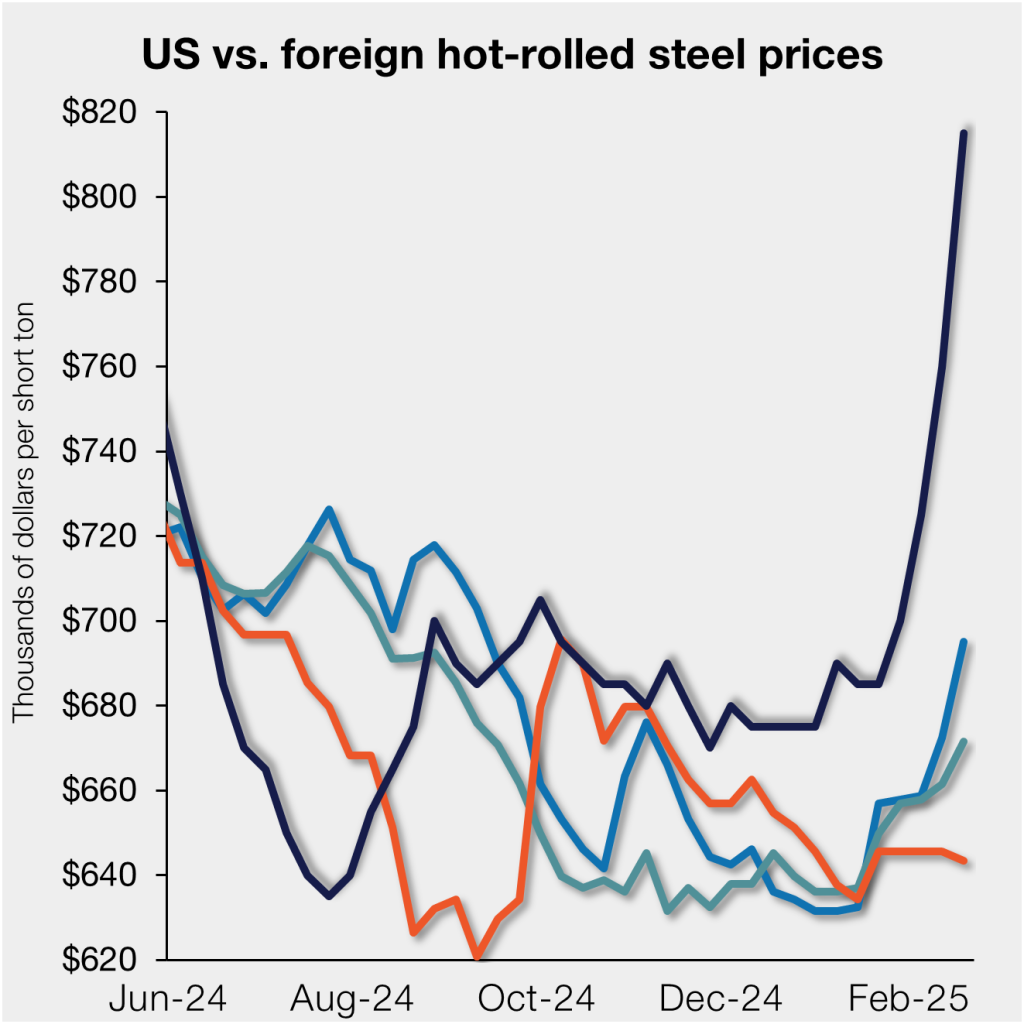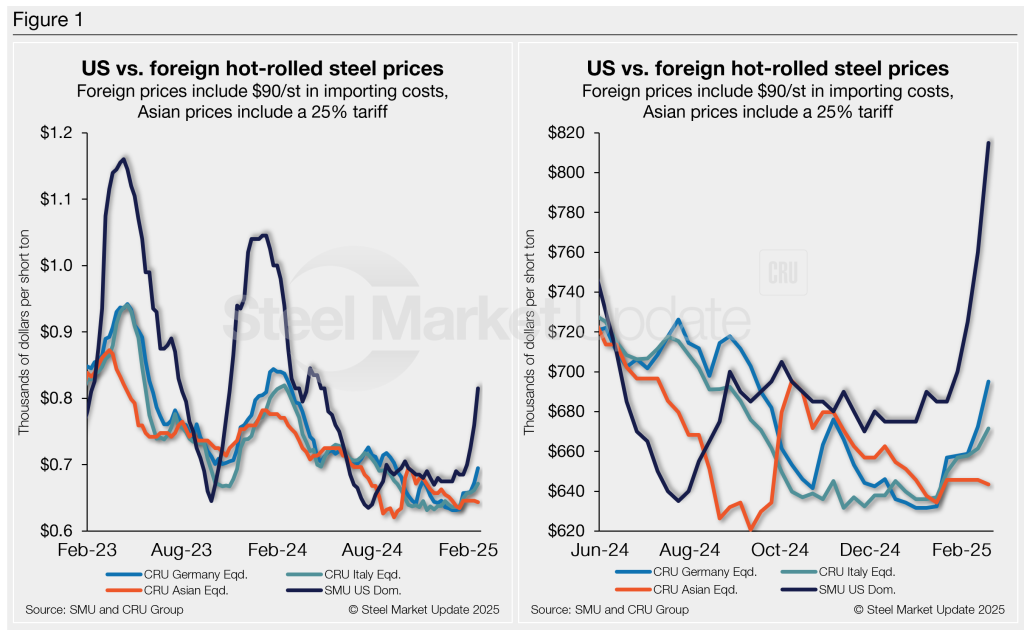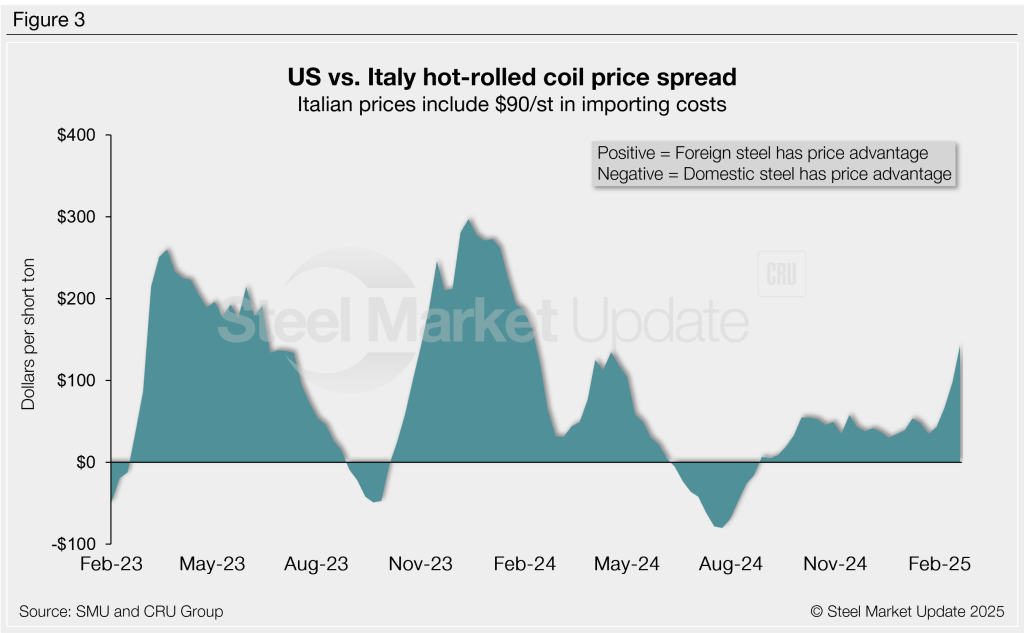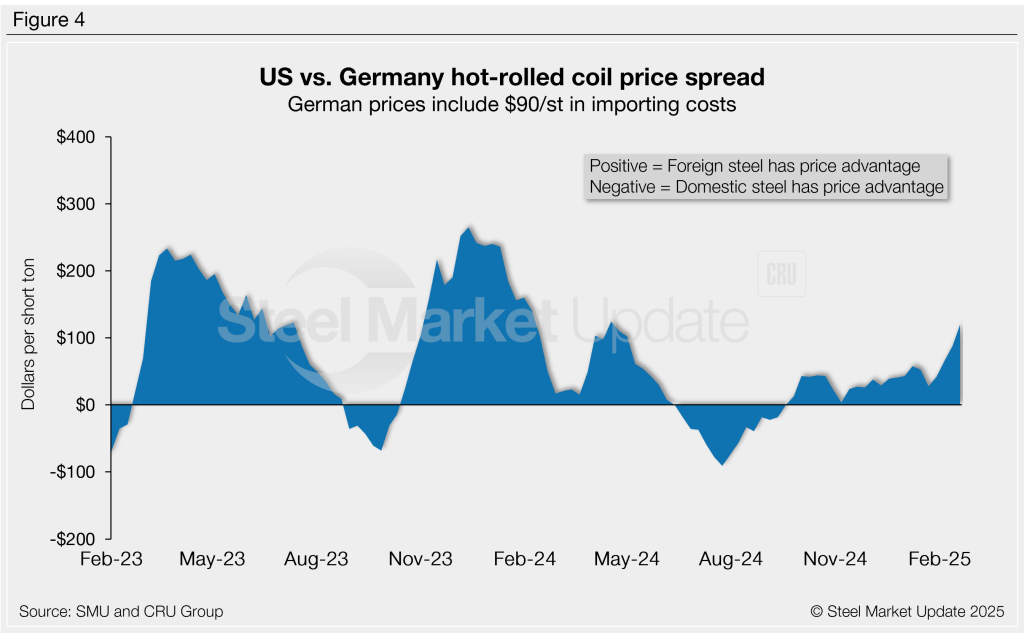Steel Products

US HR prices surge above offshore tags
Written by David Schollaert
February 21, 2025
Hot-rolled (HR) coil prices leaped in the US this week, while tags abroad saw more measured gains. The result: US hot band prices have become even more expensive than imports on a landed basis. In fact, the premium US HR prices carry over HR prices abroad now stands at a 12-month high.
SMU’s average domestic HR price this week was $815 per short ton (st), up $55/st vs. the week before and up $130/st over the past month. Prices are moving higher due to repeated mill price increases backed by threats of tariffs on imports of steel. US hot band prices are at the highest point since last April.
Domestic HR is now theoretically 17.8% more expensive than imported material, up from 13.2% last week. That’s the widest margin since last February. Recall that US prices were ~12% cheaper than imports last July.
In dollar-per-ton terms, US HR is now, on average, $145/st more expensive than offshore product (see Figure 1). That’s roughly $45/st higher vs. the prior week and up about $217/st from late July – when US tags were ~$72/st cheaper than offshore material.
The charts below compare HR prices in the US, Germany, Italy, and Asia. The left side highlights prices over the last two years and the right side zooms in to show more recent trends.

Methodology
This is how SMU calculates the theoretical spread between domestic HR coil prices (FOB domestic mills) and foreign HR coil prices (delivered to US ports): We compare SMU’s weekly US HR assessment to the CRU HR weekly indices for Germany, Italy, and East and Southeast Asian ports. This is only a theoretical calculation. Import costs can vary greatly, influencing the true market spread.
We add $90/st to all foreign prices as a rough means of accounting for freight costs, handling, and trader margin. This gives us an approximate CIF US ports price to compare to the SMU domestic HR coil price. Buyers should use our $90/st figure as a benchmark and adjust up or down based on their own shipping and handling costs.
If you import steel and want to share your thoughts on these costs, please get in touch with the author at david@steelmarketupdate.com.
Asian HRC (East and Southeast Asian ports)
As of Thursday, Feb. 20, the CRU Asian HRC price was $443/st, down $2/st vs. the week prior. Adding a 25% tariff and $90/st in estimated import costs, the delivered price of Asian HRC to the US is ~$643/st. As noted above, the latest SMU US HR price is $815/st on average.
The result: Prices for US-produced HR are theoretically $172/st higher than steel imported from Asia – roughly $58/st higher week over week (w/w). The premium is still significantly lower than roughly a year ago when US HR was as much as $281/st more expensive than Asian products.

Italian HRC
Italian HR prices were $10/st higher this week at $582/st, according to CRU. After adding import costs, the delivered price of Italian HR is, in theory, $672/st.
That means domestic HR coil is theoretically $143/st more expensive than imports from Italy. With Italian tags up just $15/st over the past month, stateside prices have surged further ahead. The spread is $45/st higher w/w and just $8/st below a recent high of $136/st last April.

German HRC
CRU’s German HR price was up $23/st to $605/st this week. After adding import costs, the delivered price of German HR coil is, in theory, $695/st.
The result: Domestic HR is theoretically $120/st more expensive than HR imported from Germany, up $32/st from last week. Stateside hot band was at an $18/st discount about four months ago. At points in 2023, in contrast, US HR was as much as $265/st more expensive than imported German hot band.

Notes: Freight is important when deciding whether to import foreign steel or buy from a domestic mill. Domestic prices are referenced as FOB the producing mill. Foreign prices are CIF, the port (Houston, NOLA, Savannah, Los Angeles, Camden, etc.). Inland freight, from either a domestic mill or from the port, can dramatically impact the competitiveness of both domestic and foreign steel. It’s also important to factor in lead times. In most markets, domestic steel will deliver more quickly than foreign steel. Effective Jan. 1, 2022, Section 232 tariffs no longer apply to most imports from the European Union. It has been replaced by a tariff rate quota (TRQ). Therefore, the German and Italian price comparisons in this analysis no longer include a 25% tariff. SMU still includes the 25% Section 232 tariff on prices from other countries. We do not include any antidumping (AD) or countervailing duties (CVD) in this analysis.

David Schollaert
Read more from David SchollaertLatest in Steel Products

Final Thoughts
The difference: The spat with Turkey was a big deal for steel. This time, the 50% reciprocal tariff for Brazil – if it goes into effect as threatened on Aug.1 – hits everything from coffee and to pig iron. It seems almost custom-built to inflict as much pain as possible on Brazil.

CRU: US rebar and wire rod prices rise alongside S232 increase
CRU Senior Steel Analyst Alexandra Anderson discusses current market and pricing dynamics for long steel products in the US.
CRU: Excessive global supply could hit rebar mill investments in US
Following the onset of the war in Ukraine in March 2022, concerns about import availability and expectations of rising demand from President Biden’s Infrastructure Bill pushed US rebar prices to record highs. In response, a flurry of new mills and capacity expansions were announced to meet the rise in demand from growth in the construction […]

Steel buyer spirits tempered by soft spot market conditions
Steel sheet buyers report feeling bogged down by the ongoing stresses of stagnant demand, news fatigue, tariff negotiations or implementation timelines, and persistent macroeconomic uncertainty.

CRU: US stainless prices to rise on expanded S232 tariffs
Stainless prices in the US market will rise, following price increases by major US producers. Our base case scenario incorporates higher US prices in the near term, despite the initial negative reaction by the market. US stainless prices will go up in 2025 H2 and will stay elevated in 2026 as tariffs on stainless […]
